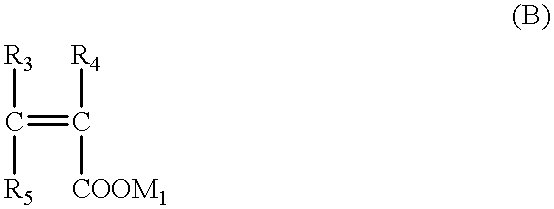Dispersant for plaster
a technology of dispersant and plaster, applied in the field of dispersant for plaster, can solve problems such as foam breaking, and achieve the effect of strong power for destroying foam
- Summary
- Abstract
- Description
- Claims
- Application Information
AI Technical Summary
Benefits of technology
Problems solved by technology
Method used
Image
Examples
example 1 (
Preparative Example 1 (preparation of dispersant 1 for Plaster)
3 mol of water was fed into a reactor fitted with a stirrer. Oxygen in the reactor was purged with nitrogen while stirring the water. The temperature of the water was raised to 75.degree. C. in a nitrogen atmosphere. A solution prepared by dissolving 1.5 mol of monomer A-1 and 1 mol of acrylic acid (molar ratio: 150 / 100) in 5 mol of water, a 20% aqueous solution prepared by dissolving 0.03 mol of ammonium persulfate in water, and 3 g of 2-mercaptoethanol were dropwise added to the water in the reactor simultaneously and separately in 2 hours. Then, a 20% aqueous-solution prepared by dissolving 0.03 mol of ammonium persulfate in water was dropwise added to the reaction system in 30 minutes. After the completion of the dropwise addition, the reaction system was maintained at that temperature (75.degree. C.) for one hour. That is, aging was effected. After the completion of the aging, the temperature of the reaction system ...
example 2 (
Preparative Example 2 (preparation of dispersant 2 for plaster)
5 mol of water was fed into a reactor fitted with a stirrer. Air in the reactor was purged with nitrogen while stirring the water. The temperature of the water was raised to 75.degree. C. in a nitrogen atmosphere. A solution prepared by dissolving 0.5 mol of monomer A-2 and 1 mol of methacrylic acid (molar ratio: 50 / 100) in 6 mol of water, a 20% aqueous solution prepared by dissolving 0.01 mol of ammonium persulfate in water, and 3 g of 2-mercaptoethanol were dropwise added to the water in the reactor simultaneously and separately in 2 hours. Then, a 20% aqueous solution prepared by dissolving 0.03 mol of ammonium persulfate in water was dropwise added to the reaction system in 30 minutes. After the completion of the dropwise addition, the reaction system was maintained at that temperature (75.degree. C.) for one hour. That is, aging was effected. After the completion of the aging, the temperature of the reaction system ...
example 3 (
Preparative Example 3 (preparation of dispersant 3 for plaster)
7 mol of water was fed into a reactor fitted with a stirrer. Oxygen in the reactor was purged with nitrogen while stirring the water. The temperature of the water was raised to 95.degree. C. in a nitrogen atmosphere. A solution prepared by dissolving 0.2 mol of monomer A-3 and 1 mol of monosodium maleate (molar ratio: 20 / 100) in 8 mol of hot water at 90.degree. C., a 20% aqueous solution prepared by dissolving 0.01 mol of ammonium persulfate in water, and 3 g of 2-mercaptoethanol were dropwise added to the water in the reactor simultaneously and separately in 2 hours. Then, a 20% aqueous solution prepared by dissolving 0.03 mol of ammonium persulfate in water was dropwise added to the reaction system in 30 minutes. After the completion of the dropwise addition, the reaction system was maintained at that temperature (95.degree. C.) for one hour. That is, aging was effected. After the completion of the aging, 9 g of a 35% ...
PUM
| Property | Measurement | Unit |
|---|---|---|
| Percent by mass | aaaaa | aaaaa |
| Substance count | aaaaa | aaaaa |
| Weight | aaaaa | aaaaa |
Abstract
Description
Claims
Application Information
 Login to View More
Login to View More - R&D
- Intellectual Property
- Life Sciences
- Materials
- Tech Scout
- Unparalleled Data Quality
- Higher Quality Content
- 60% Fewer Hallucinations
Browse by: Latest US Patents, China's latest patents, Technical Efficacy Thesaurus, Application Domain, Technology Topic, Popular Technical Reports.
© 2025 PatSnap. All rights reserved.Legal|Privacy policy|Modern Slavery Act Transparency Statement|Sitemap|About US| Contact US: help@patsnap.com



